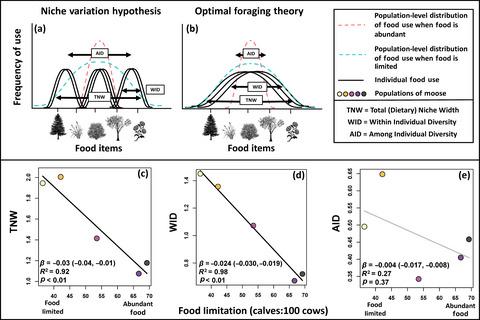当前位置:
X-MOL 学术
›
J. Anim. Ecol.
›
论文详情
Our official English website, www.x-mol.net, welcomes your
feedback! (Note: you will need to create a separate account there.)
A test of the Niche Variation Hypothesis in a ruminant herbivore
Journal of Animal Ecology ( IF 3.5 ) Pub Date : 2020-10-19 , DOI: 10.1111/1365-2656.13351 Brett R Jesmer 1, 2, 3, 4, 5 , Matthew J Kauffman 1, 2, 3, 6 , Melanie A Murphy 1, 7 , Jacob R Goheen 1, 2
Journal of Animal Ecology ( IF 3.5 ) Pub Date : 2020-10-19 , DOI: 10.1111/1365-2656.13351 Brett R Jesmer 1, 2, 3, 4, 5 , Matthew J Kauffman 1, 2, 3, 6 , Melanie A Murphy 1, 7 , Jacob R Goheen 1, 2
Affiliation

|
Despite the shared prediction that the width of a population's dietary niche expands as food becomes limiting, the Niche Variation Hypothesis (NVH) and Optimal Foraging Theory (OFT) offer contrasting views about how individuals alter diet selection when food is limited. Classical OFT predicts that dietary preferences do not change as food becomes limiting, so individuals expand their diets as they compensate for a lack of preferred foods. In contrast, the NVH predicts that among-individual variation in cognition, physiology, or morphology create functional trade-offs in foraging efficiency, thereby causing individuals to specialize on different subsets of food as food becomes limiting. To evaluate (a) the predictions of the NVH and OFT and (b) evidence for physiological and cognitive-based functional trade-offs, we used DNA microsatellites and metabarcoding to quantify the diet, microbiome, and genetic relatedness (a proxy for social learning) of 218 moose (Alces alces) across six populations that varied in their degree of food limitation. Consistent with both the NVH and OFT, dietary niche breadth increased with food limitation. Increased diet breadth of individuals-rather than increased diet specialization-was strongly correlated with both food limitation and dietary niche breadth of populations, indicating that moose foraged in accordance with OFT. Diets were not constrained by inheritance of the microbiome or inheritance of diet selection, offering support for the little-tested hypothesis that functional trade-offs in food use (or lack thereof) determine whether populations adhere to the predictions of the NVH or OFT. Our results indicate that both the absence of strong functional trade-offs and the digestive physiology of ruminants provide contexts under which populations should forage in accordance with OFT rather than the NVH. Also, because dietary niche width increased with increased food limitation, OFT and the NVH provide theoretical support for the notion that plant-herbivore interaction networks are plastic rather than static, which has important implications for understanding interspecific niche partitioning. Lastly, because population-level dietary niche breadth and calf recruitment are correlated, and because calf recruitment can be a proxy for food limitation, our work demonstrates how diet data can be employed to understand a populations' proximity to carrying capacity.
中文翻译:

反刍食草动物的生态位变异假设检验
尽管人们的共同预测是,随着食物变得有限,人口的饮食生态位的宽度会扩大,但生态位变异假设 (NVH) 和最佳觅食理论 (OFT) 就食物有限时个体如何改变饮食选择提供了截然不同的观点。经典的 OFT 预测饮食偏好不会随着食物的限制而改变,因此个人会扩大饮食以弥补首选食物的缺乏。相比之下,NVH 预测,认知、生理或形态的个体差异会在觅食效率方面产生功能权衡,从而导致个体在食物变得有限时专注于不同的食物子集。评估 (a) NVH 和 OFT 的预测以及 (b) 基于生理和认知的功能权衡的证据,我们使用 DNA 微卫星和元条形码来量化 218 只驼鹿 (Alces alces) 的饮食、微生物组和遗传相关性(社会学习的代表),这些驼鹿的食物限制程度各不相同。与 NVH 和 OFT 一致,饮食生态位宽度随着食物限制而增加。个体饮食广度的增加——而不是饮食专业化的增加——与食物限制和种群的饮食生态位广度密切相关,表明驼鹿按照 OFT 觅食。饮食不受微生物组遗传或饮食选择遗传的限制,这为鲜为人知的假设提供了支持,即食物使用中的功能权衡(或缺乏)决定了人群是否遵守 NVH 或 OFT 的预测。我们的结果表明,缺乏强大的功能权衡和反刍动物的消化生理学提供了种群应该根据 OFT 而不是 NVH 觅食的背景。此外,由于饮食生态位宽度随着食物限制的增加而增加,OFT 和 NVH 为植物 - 食草动物相互作用网络是可塑性而非静态的概念提供了理论支持,这对于理解种间生态位划分具有重要意义。最后,因为人口水平的饮食生态位宽度和小牛补充是相关的,而且因为小牛补充可以代表食物限制,我们的工作展示了如何利用饮食数据来了解人口与承载能力的接近程度。
更新日期:2020-10-19
中文翻译:

反刍食草动物的生态位变异假设检验
尽管人们的共同预测是,随着食物变得有限,人口的饮食生态位的宽度会扩大,但生态位变异假设 (NVH) 和最佳觅食理论 (OFT) 就食物有限时个体如何改变饮食选择提供了截然不同的观点。经典的 OFT 预测饮食偏好不会随着食物的限制而改变,因此个人会扩大饮食以弥补首选食物的缺乏。相比之下,NVH 预测,认知、生理或形态的个体差异会在觅食效率方面产生功能权衡,从而导致个体在食物变得有限时专注于不同的食物子集。评估 (a) NVH 和 OFT 的预测以及 (b) 基于生理和认知的功能权衡的证据,我们使用 DNA 微卫星和元条形码来量化 218 只驼鹿 (Alces alces) 的饮食、微生物组和遗传相关性(社会学习的代表),这些驼鹿的食物限制程度各不相同。与 NVH 和 OFT 一致,饮食生态位宽度随着食物限制而增加。个体饮食广度的增加——而不是饮食专业化的增加——与食物限制和种群的饮食生态位广度密切相关,表明驼鹿按照 OFT 觅食。饮食不受微生物组遗传或饮食选择遗传的限制,这为鲜为人知的假设提供了支持,即食物使用中的功能权衡(或缺乏)决定了人群是否遵守 NVH 或 OFT 的预测。我们的结果表明,缺乏强大的功能权衡和反刍动物的消化生理学提供了种群应该根据 OFT 而不是 NVH 觅食的背景。此外,由于饮食生态位宽度随着食物限制的增加而增加,OFT 和 NVH 为植物 - 食草动物相互作用网络是可塑性而非静态的概念提供了理论支持,这对于理解种间生态位划分具有重要意义。最后,因为人口水平的饮食生态位宽度和小牛补充是相关的,而且因为小牛补充可以代表食物限制,我们的工作展示了如何利用饮食数据来了解人口与承载能力的接近程度。











































 京公网安备 11010802027423号
京公网安备 11010802027423号